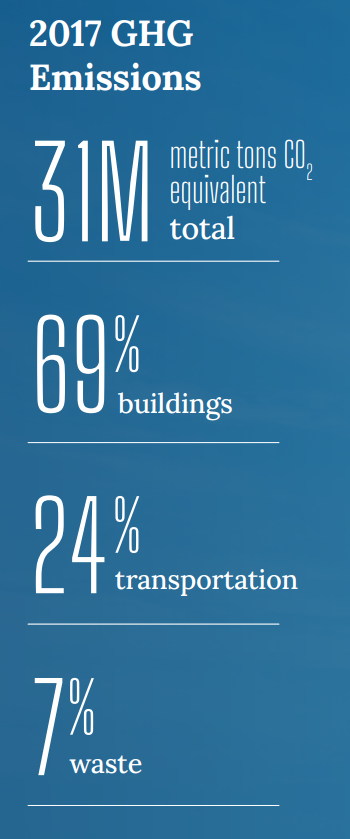Electrify Chicago
An independent tool for viewing City of Chicago building data
According to the
2022 Chicago Climate Action Plan,
69% of Chicago's emissions come from buildings, making
building emissions our biggest challenge and our biggest opportunity as a city
to tackle climate change. At Electrify Chicago, we showcase building performance using
publicly available data supplemented by community-submitted photographs and building
owners.
Start by looking at Chicago's buildings with the highest greenhouse gas intensity i.e. emissions per square foot. Large, efficient, buildings can perform much better than very inefficient small buildings on this metric.
New Article
📰 $30 Million In Missed Fines
The City Of Chicago failed to collect $30 million in potential fines from the building benchmarking ordinance, reducing transparency and accountability.
Legislative update! 🎉
As of late January 2024, legislation is being introduced to require new use more efficient forms of water and space heating, via the Clean And Affordable Buildings Ordinance (CABO), which will reduce the number of highly polluting and inefficient buildings that end up on this site.
If you're in Chicago,
write to your alderman to support the CABO!
Chicago Buildings by Greenhouse Gas Intensity
Note: Data includes large Chicago buildings with data from 2022, unless explicitly stated otherwise.
Note: This data only includes buildings whose emissions are reported
under the
Chicago Energy Benchmarking Ordinance. According to the City “As of 2016,
this list includes all commercial, institutional, and residential buildings larger than
50,000 square feet.” This dataset is also then filtered to only buildings with
reported emissions > 1,000 metric tons CO2 equivalent.
The latest year of data is from 2022, but we update the site regularly when new data is available, and some buildings may have failed to report that year, and only have older data available.
| Property Name / address | Primary Property Type |
Greenhouse Gas Intensity (kg CO2 eq./sqft) |
Total Greenhouse Emissions (metric tons CO2 eq.) |
|---|---|---|---|
|
Goudy Elementary, William C -CPS
(CPS)
5120 N Winthrop Ave
| K-12 School | 4.0 kg/sqft
Lowest 10%
| 391 tons
Lowest 16%
|
|
Castellanos Elementary -CPS
(CPS)
2524 S Central Ave
| K-12 School | 4.0 kg/sqft
Lowest 10%
| 334 tons
Lowest 11%
|
|
Bridge Elementary, Norman -CPS
(CPS)
3800 N New England Ave
| K-12 School | 4.0 kg/sqft
Lowest 10%
| 514 tons
Lowest 28%
|
|
Taft HS -CPS
(CPS)
6545 W Hurlbut St
| K-12 School | 4.0 kg/sqft
Lowest 10%
| 2,111 tons
Highest 22%
|
|
Kennelly Square Condominium Association
1749 N Wells St
| Multifamily Housing | 4.0 kg/sqft
Lowest 10%
| 1,309 tons
Highest 36%
|
|
250 270 Pearson
250 270 E Pearson St
| Multifamily Housing | 4.0 kg/sqft
Lowest 10%
| 2,463 tons
Highest 18%
|
|
5123 5135 S UNIVERSITY AVE
5123 5135 S UNIVERSITY AVE
| Multifamily Housing | 4.0 kg/sqft
Lowest 10%
| 236 tons
Lowest 4%
|
|
660 676 W IRVING PARK RD
660 676 W IRVING PARK RD
| Multifamily Housing | 4.0 kg/sqft
Lowest 10%
| 820 tons
Lowest 47%
|
|
Saint Luke Church & Academy
1500 W Belmont Ave
| Other - Education | 4.0 kg/sqft
Lowest 10%
| 255 tons
Lowest 5%
|
|
4245 N OAK PARK AVE
4245 N OAK PARK AVE
| Senior Living Community | 4.0 kg/sqft
Lowest 10%
| 221 tons
Lowest 3%
|
|
Manchester Building Lofts Condominium Association
🕰️
2033 2045 W CHARLESTON ST
| Multifamily Housing | 4.0 kg/sqft | 210 tons |
|
Josephinum Academy
🕰️
1501 N Oakley Blvd
| K-12 School | 4.0 kg/sqft | 337 tons |
|
Smith Senior Living
2320 W 113TH PL
| Senior Living Community | 4.0 kg/sqft
Lowest 10%
| 1,497 tons
Highest 31%
|
|
First Presbyterian Church of Chicago
🕰️
6400 S. Kimbark Avenue
| Worship Facility | 4.0 kg/sqft | 199 tons |
|
225 W Ohio St
225 W Ohio St
| Office | 4.0 kg/sqft
Lowest 10%
| 244 tons
Lowest 4%
|
Data Source:
Chicago Energy Benchmarking Data
